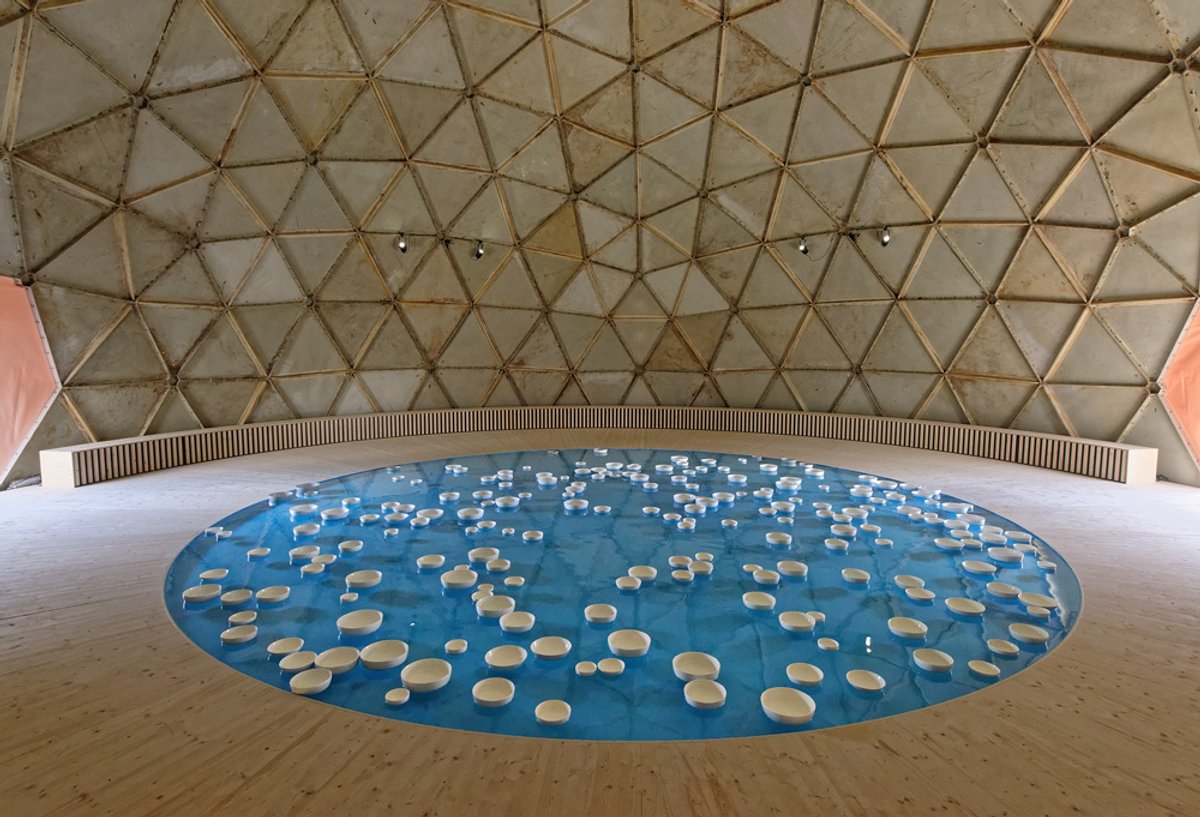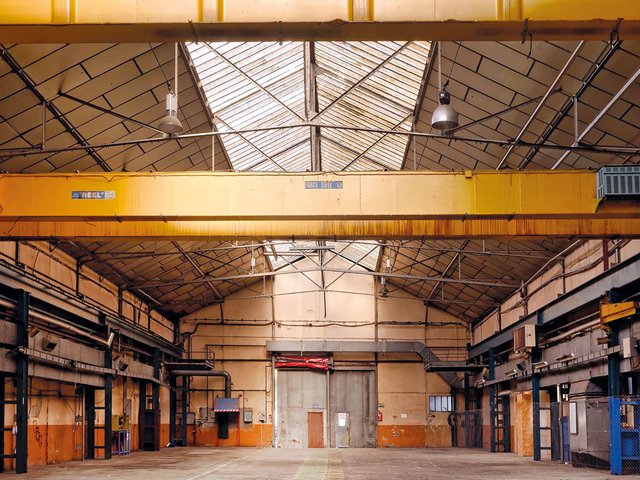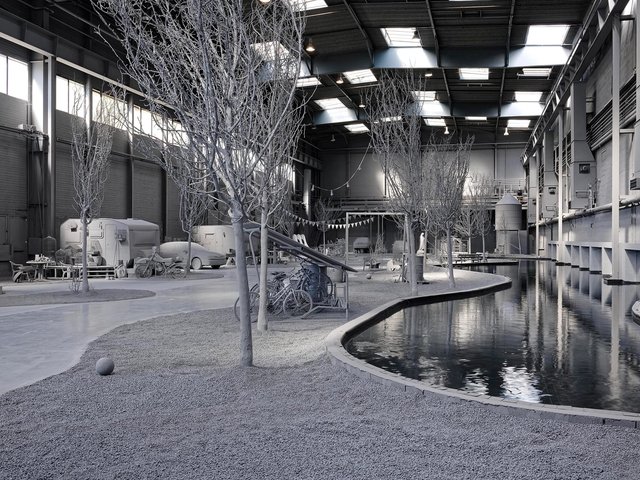“Sound is like a first language [that] we can share before words,” says Emma Lavigne, the curator of the 14th Biennale de Lyon (20 September-7 January 2018). She says this as she stands in front of the clanking installation climamen V4 (2017) by Céleste Boursier-Mougenot, which almost drowns out her words. The piece is one of the three main elements of the biennial, housed inside a dome by Richard Buckminster Fuller and situated in Place Antonin Poncet in the centre of the city. The work exemplifies Lavigne’s ambition to create a “dialogue with other fields”, in this case architecture.
The mixture between the mid 20th-century structure and a contemporary work sets the tone for the two main group exhibitions that make up the biennial shows, one in the Musée d’Art Contemporain (MAC Lyon) and the second in the Sucrière, a vast industrial building that was once a sugar storage warehouse. There are around 80 artists in the biennial, ranging from Modernist pioneers Marcel Duchamp and Hans Arp to contemporary stars such as Rivane Neuenschwander and Tomás Saraceno.
This year’s biennial is titled Floating Worlds and its theme, as it was for the last edition and will be for the next, is “modernity”. The biennial’s artistic director Thierry Raspail has invited different curators for each edition to tackle the theme in their own way. He chose the Hayward director Ralph Rugoff to undertake the first of the modernity trilogy as, he says, the theme was “too French” and wanted an international perspective to kick it off. This time he has gone for Lavigne who is “more a historian of art, knows a lot and is totally different [to Rugoff]”.
Although Lavigne says that the inclusion of lots of sound works was not a deliberate act but rather a coincidence, it is this aspect that resonates across the biennial’s two main exhibitions and its dome in the centre of the city.
Here we select the key works see (and hear) at the biennial:

José da Silva
Céleste Boursier-Mougenot’s climamen V4 (2017) and Richard Buckminster Fuller’s Radôme (1957), Place Antonin Poncet
The French artist Céleste Boursier-Mougenot’s installation of around 40 bowls floating in a shallow pool, propelled by an invisible current and clinking into each other produce an amplified chiming that is echoed by Buckminster Fuller’s dome. The water is kept at 30C in order to provide “optimum resonance”, according to a press statement. The work's origins, however, are slightly more DIY, having started with a paddling pool and breakfast cereal bowls, Boursier-Mougenot says. The geodesic dome by Buckminster Fuller gets its first outing in more than two decades from storage in the collection of the Pompidou Centre, and provides the perfect foil for Boursier-Mougenot’s work.
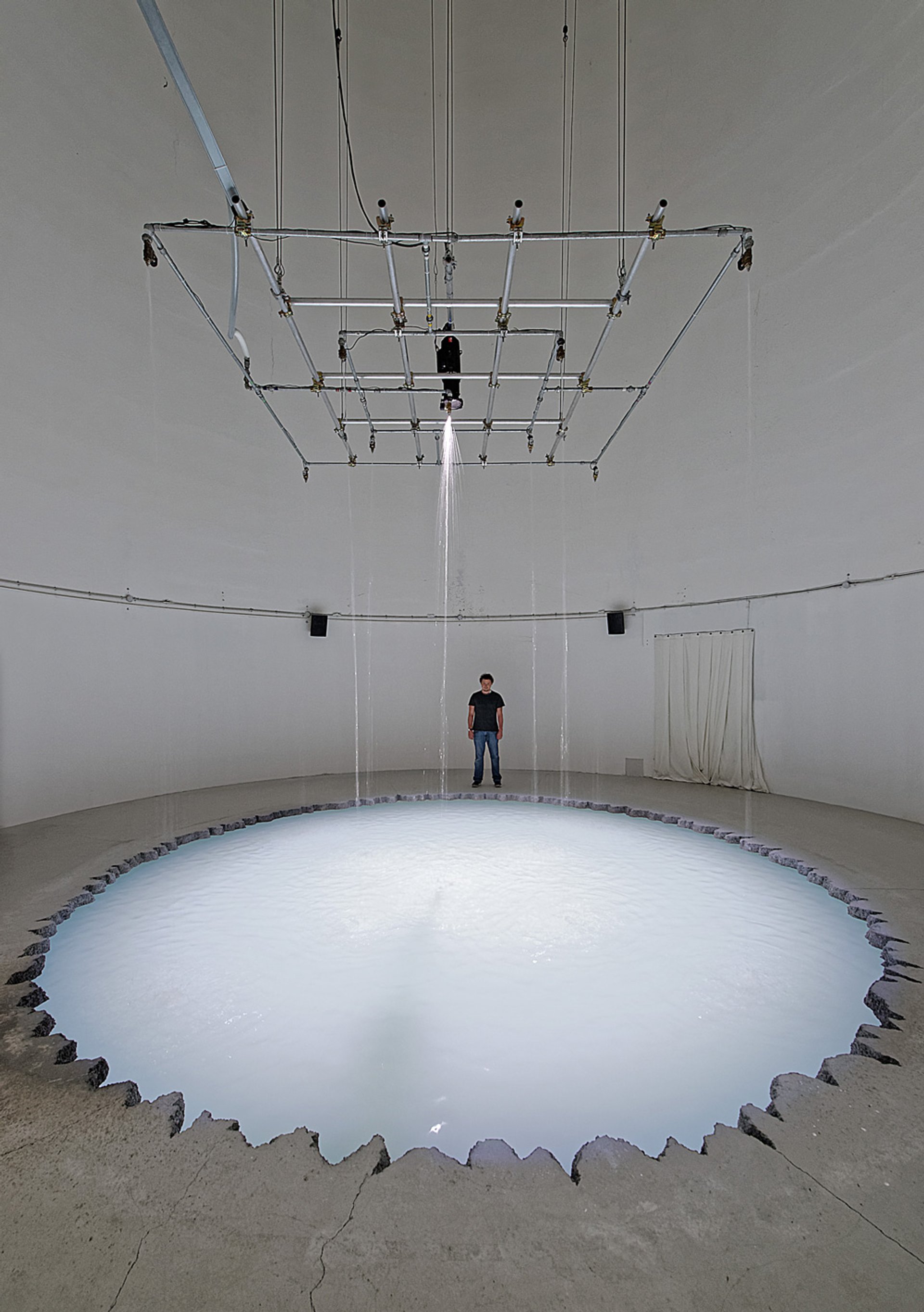
Biennale de Lyon. Photo: Blaise Adilon
Doug Aitkens’s Sonic Fountain II (2013-17), Sucrière
Doug Aitkens's work can often seem gimmicky or people-pleasing. But Sonic Fountain II, with its plumbing rig high-up above a milky blue pond, is a subtle and moving affair. The drips falling from the taps above follow a score that is amplified by microphones as they hit the water in the crater below and echo around the space, a former silo. In a press statement the artist says that the work “lays the architecture bare to reveal its rhythm, its tempo and its language”.
Bruce Conner’s Crossroads (1976), Sucrière
There is noticeable a lack of works that engage in current political events. Instead, older works become inadvertently relevant, such the Forever Immigrant (2017) by the Portuguese artist Marco Godinho, which is the latest version of a decade-old installation, and more pertinently Bruce Conner’s Crossroads (1970). The footage of nuclear bomb testing off the Bikini Atoll in 1946 is still as terrifying as it was when first shown, especially as it has gained renewed relevance following recent tensions between North Korea and the US. The power of the explosions and the simple repetition of the 24 different detonations—filmed by the US military and previously classified information—is familiar (the unmistakeable shape of the mushroom cloud) but still awe-inspiring on each renewed viewing. (For a dreamy counterpoint, see Conner’s Easter Morning, 1968-2008, at the Musée d’Art Contemporain, which was shot on 8mm film and is bathed in warm sunlight).
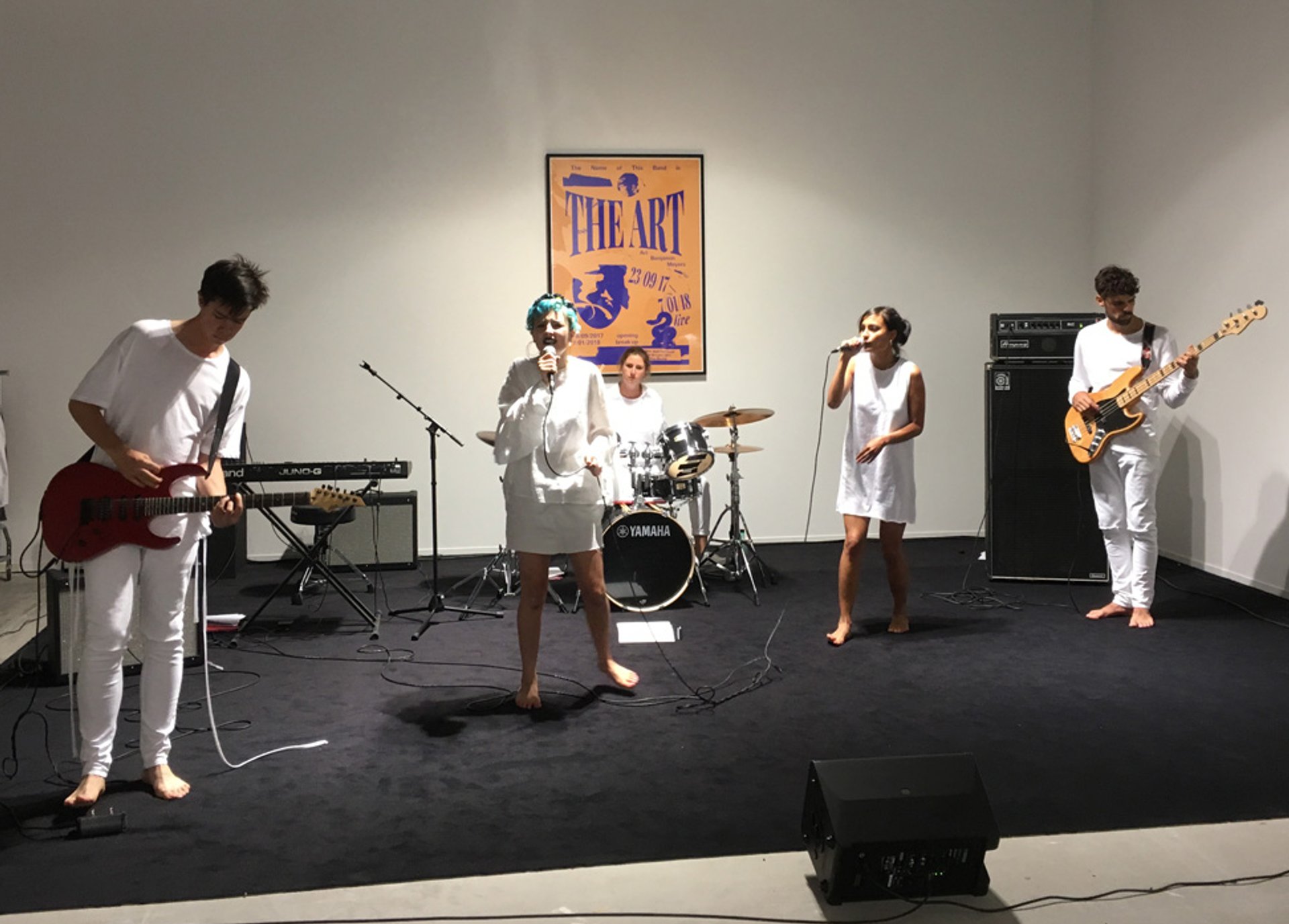
José da Silva
Ari Benjamin Meyers’s The Art (2016), Sucrière
Can a pop band make art? Can a band be art? Ari Benjamin Meyers’s The Art is just that, a pop group made up of five art students thrown together for the duration of the biennial. The group— all dressed in white and belting out their improvised tunes (singing about someone who has “the blues”)—is surrounded by the typical band ephemera, such as posters and t-shirts with their “tour dates”, all of which are at the Biennale de Lyon. The Art is due to play most weekends throughout the event before announcing their break-up on the final day of the biennial.

Photo: José da Silva
Tomás Saraceno’s Hyperweb of the present (2017), Sucrière
Arachnophobes might want to skip this installation in one of the former silos of the Sucrière building. Inside, in almost pitch black, a big spot-lit spider plucks at its web with nothing between the creature and audience (it appears at first to be in a glass case but it is just a metal frame). As the arachnid moves around its web, sensitive microphones pick up the vibrations it makes and these are amplified around the space. Beside the spider is a projection of the Large Magellanic Cloud, a galaxy 163,000 light years away from earth, taking us from the vast collection of stars to the “miniature universe of a spider’s web”, according to the artist’s press statement.

Biennale de Lyon. Photo: Blaise Adilon
Rivane Neuenschwander’s Bataille (2017), Musée d’Art Contemporain
“Occupée”, “utopie”, “colère”, “dignité”, “j’emmerde”, “banlieues”, “mobilise” are just some of the words made of fabric that visitors to the museum can use to make phrases on a vast pin board or on themselves using safety pins. The work by the Brazilian artist Rivane Neuenschwander, titled Bataille (2017), is one of only a few in the biennial to directly address current political issues. Made especially for the event, the words in the work are taken from protest banners from around the world and made into labels that resemble clothing brands. The piece, whose title means “battle” in French, is influenced by concrete poetry and the work of the Situationists.
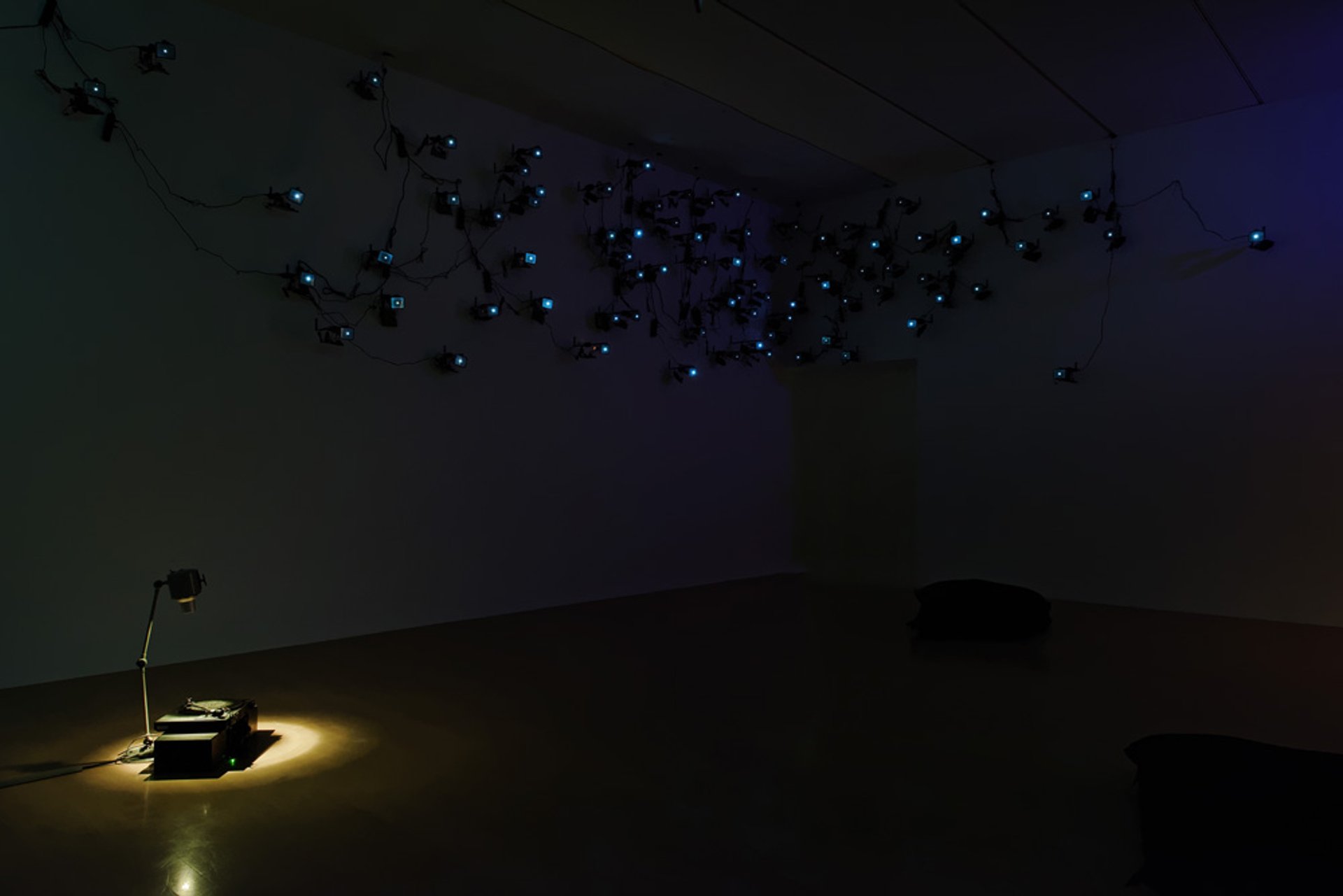
Courtesy of the artist, Biennale de Lyon 2017, Casas Riegner. Photo: Blaise Adilon
Icaro Zorbar’s Home (2017), Musée d’Art Contemporain
This installation by the Colombian artist Icaro Zorba uses mostly obsolete technology to create an immersive, slow moving world. Watching over from above like Medieval gargoyles are 89 tiny television screens, while a projection of a window shows a bird flutter by and a record player on the floor plays out an incredibly slow soundtrack, which resembles a recording made deep beneath the earth’s crust. Zorbar calls these outdated technologies his “little monsters” and plays with their aesthetic allure. He writes that he has “always been fascinated with discovering the inside of the machine” and pays attention to what its “apparatus is offering”. “Sometime the machine screams, sometimes it whispers”, he adds.
• 14th Biennale de Lyon: Floating Worlds, 20 September-7 January 2018


